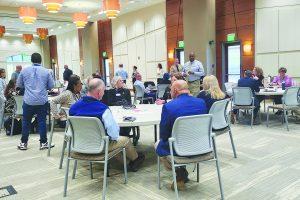Representatives from the city and county gathered for an OMNI Institute meeting on April 22, marking the first part of a six-month program to reduce opioid use in the community. The three-hour meeting focused on the impact of opioids in the area, addiction education, and community discussion.

A mix of community leaders, such as Pam Cobler and Garrett Dillard, of the Reed Creek and Iriswood districts respectively, and Martinsville Commonwealth’s Attorney Andrew Hall were among those attending, along with Henry County Sheriff Wayne Davis, Martinsville Chief of Police Robert Fincher, and Martinsville Sheriff Steve Draper.
“I’ve seen the impact on struggling families and how they get involved in the opioids, and how it impacts children and their loss of loved ones,” said 1st Sgt. James Ayers.
“We see the opioid epidemic addiction permeating so many different aspects of our society, such as mental health; people try to medicate themselves. I’m looking for solutions at this point.,” said Hall. “The proliferation of opioids has created a lot of vulnerable people. We want to reduce any instances of people being vulnerable,” Fincher said.
“I see substance use disorder as a disease of despair and not a moral family,” Nancy Bell, of the Virginia Health Department, said.
“We’ve spent a fortune hiring an army of community health workers.” Ariel Johnson, the director of Harm Reduction and the Warming Shelter, said. “Harm reduction focuses on pre-contemplative where folks are left in the dark. I believe that the opposite of addiction is connection.”
Many attendees shared brief stories about how opioid use had negatively impacted their personal lives as driving reasons behind their choice to help with the epidemic. The impact on children and families was a special point of concern.
“Ninety percent of our children in foster care were due to some type of substance abuse,” said Children’s Services Act Coordinator, Robin Turner.
Data was shown about the current opioid problem in the area, but the chart only showed a slice of reported use. “What I love about this data is that it comes from Purdue Pharma, who directly targeted our community, targeting the individuals that were working in the factory,” said Johnson.
Care for addicts who faced incarceration was discussed by Draper and Davis.
“We can put them in jail for three, four, five years, and the first thing they look for is a fix,” said Hall.
To reduce drug abuse, inmates are encouraged to teach courses and in turn receive points in a system that allows them to rent approved movies and listen to approved music on their tablets.
“You have people graduate with certificates,” said Turner. “When they’re there and take the time to take that, they can come out as a better citizen and better person.”
Many inmates will leave the jail before a program is fully completed, and both sheriffs noted that inmates have to keep up with their education after being released.
The meeting showed there is support for a successful alliance between all of the organizations in the area.
“We have a lot of organizations that are capable of coming together,” said Brandon Martin, the county’s public information officer.
“It’s a competition. We need to take it away from being a competition,” said Dillard, who wants all of the organizations to work together to solve the drug problem.
“All of our goals should be that we want to get to where there’s a scarcity of individuals we are serving,” Johnson said.
Attendees also agreed that the community is heavily faith-based and that meetings would benefit from religious representation.
The next meeting is set for July as officials continue crafting a community plan using community data and discussion over the multi-meeting course. The final plan will be presented at the end of September to help the localities decide how and where to best use their resources.



